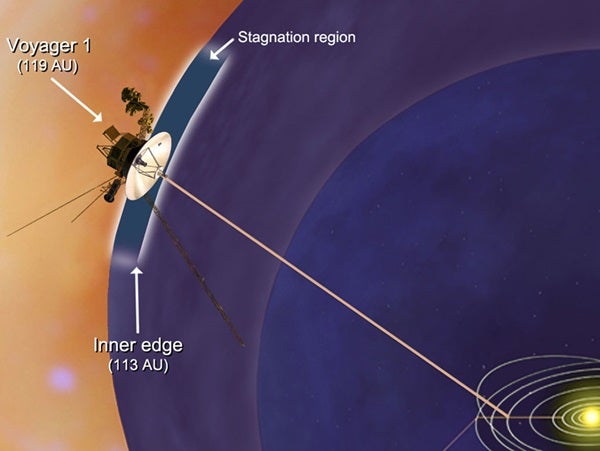“Voyager tells us now that we’re in a stagnation region in the outermost layer of the bubble around our solar system,” said Ed Stone from the California Institute of Technology (Caltech) in Pasadena. “Voyager is showing that what is outside is pushing back. We shouldn’t have long to wait to find out what the space between stars is really like.”
Although Voyager 1 is about 11 billion miles (18 billion kilometers) from the Sun, it is not yet in interstellar space. In the latest data, the direction of the magnetic field lines has not changed, indicating Voyager is still within the heliosphere — the bubble of charged particles the Sun blows around itself. The data do not reveal exactly when Voyager 1 will make it past the edge of the solar atmosphere into interstellar space, but suggest it will be in a few months to a few years.
Scientists previously reported the outward speed of the solar wind had diminished to zero in April 2010, marking the start of the new region. Mission managers rolled the spacecraft several times this spring and summer to help scientists discern whether the solar wind was blowing strongly in another direction. It was not. Voyager 1 is plying the celestial seas in a region similar to Earth’s doldrums, where there is little wind.
During this past year, Voyager’s magnetometer also detected a doubling in the intensity of the magnetic field in the stagnation region. Like cars piling up at a clogged freeway off-ramp, the increased intensity of the magnetic field shows that inward pressure from interstellar space is compacting it.
Voyager has been measuring energetic particles that originate from inside and outside our solar system. Until mid-2010, the intensity of particles originating from inside our solar system had been holding steady. But during the past year, the intensity of these energetic particles has been declining, as though they are leaking out into interstellar space. The particles are now half as abundant as they were during the previous five years.
At the same time, Voyager has detected a 100-fold increase in the intensity of high-energy electrons from elsewhere in the galaxy diffusing into our solar system from outside, which is another indication of the approaching boundary.
“We’ve been using the flow of energetic charged particles at Voyager 1 as a kind of wind sock to estimate the solar wind velocity,” said Rob Decker from Johns Hopkins University in Laurel, Maryland. “We’ve found that the wind speeds are low in this region and gust erratically. For the first time, the wind even blows back at us. We are evidently traveling in completely new territory. Scientists had suggested previously that there might be a stagnation layer, but we weren’t sure it existed until now.”
“Voyager tells us now that we’re in a stagnation region in the outermost layer of the bubble around our solar system,” said Ed Stone from the California Institute of Technology (Caltech) in Pasadena. “Voyager is showing that what is outside is pushing back. We shouldn’t have long to wait to find out what the space between stars is really like.”
Although Voyager 1 is about 11 billion miles (18 billion kilometers) from the Sun, it is not yet in interstellar space. In the latest data, the direction of the magnetic field lines has not changed, indicating Voyager is still within the heliosphere — the bubble of charged particles the Sun blows around itself. The data do not reveal exactly when Voyager 1 will make it past the edge of the solar atmosphere into interstellar space, but suggest it will be in a few months to a few years.
Scientists previously reported the outward speed of the solar wind had diminished to zero in April 2010, marking the start of the new region. Mission managers rolled the spacecraft several times this spring and summer to help scientists discern whether the solar wind was blowing strongly in another direction. It was not. Voyager 1 is plying the celestial seas in a region similar to Earth’s doldrums, where there is little wind.
During this past year, Voyager’s magnetometer also detected a doubling in the intensity of the magnetic field in the stagnation region. Like cars piling up at a clogged freeway off-ramp, the increased intensity of the magnetic field shows that inward pressure from interstellar space is compacting it.
Voyager has been measuring energetic particles that originate from inside and outside our solar system. Until mid-2010, the intensity of particles originating from inside our solar system had been holding steady. But during the past year, the intensity of these energetic particles has been declining, as though they are leaking out into interstellar space. The particles are now half as abundant as they were during the previous five years.
At the same time, Voyager has detected a 100-fold increase in the intensity of high-energy electrons from elsewhere in the galaxy diffusing into our solar system from outside, which is another indication of the approaching boundary.
“We’ve been using the flow of energetic charged particles at Voyager 1 as a kind of wind sock to estimate the solar wind velocity,” said Rob Decker from Johns Hopkins University in Laurel, Maryland. “We’ve found that the wind speeds are low in this region and gust erratically. For the first time, the wind even blows back at us. We are evidently traveling in completely new territory. Scientists had suggested previously that there might be a stagnation layer, but we weren’t sure it existed until now.”










